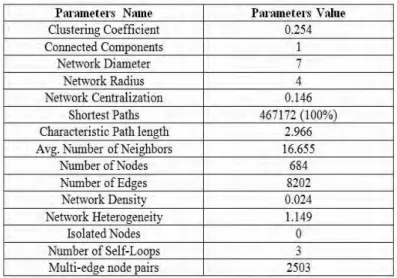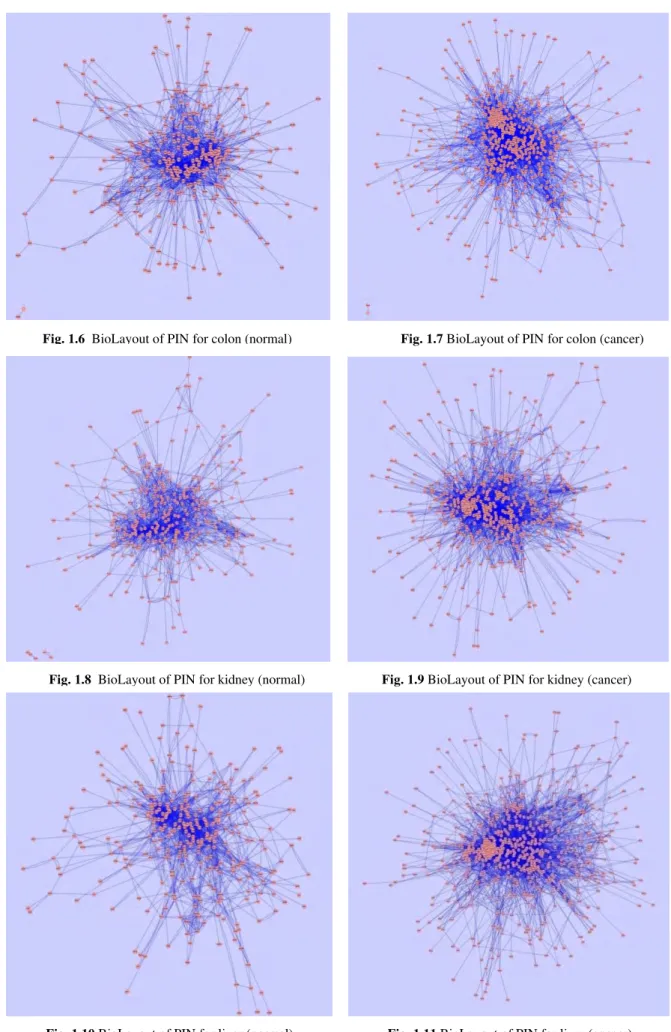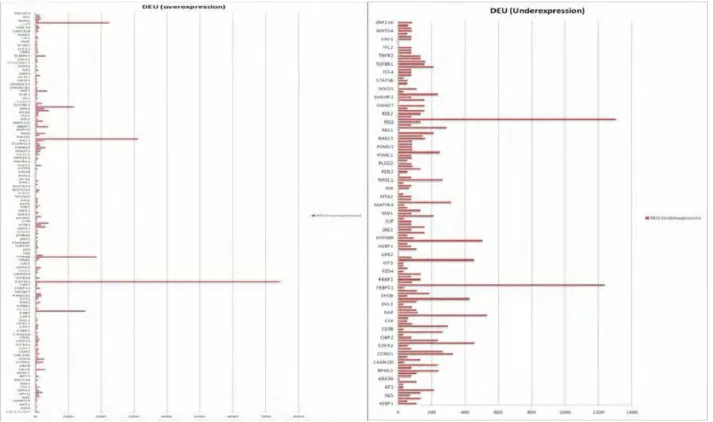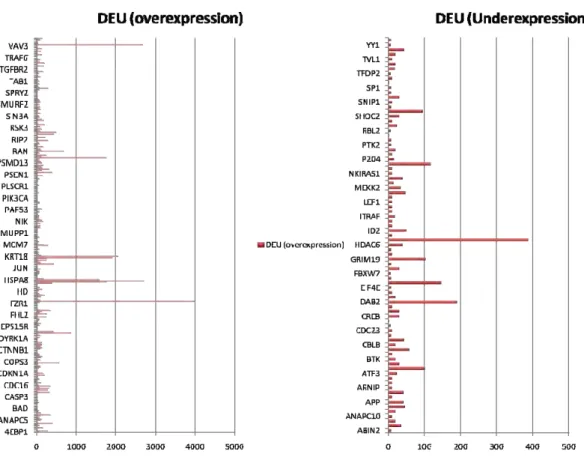Article
Changes in protein interaction networks between normal and cancer
conditions: Total chaos or ordered disorder?
K. M. Taufiqur Rahman, Md. Fahmid Islam, Rajat Suvra Banik, Ummay Honi, Farhana Sharmin Diba, Sharmin Sultana Sumi, Shah Md. Tamim Kabir, Md. Shamim Akhter
Biotechnology and Genetic Engineering Discipline, Khulna University, Bangladesh E-mail: fahmid_islam9891@yahoo.com
Received 15 November 2012; Accepted 18 December 2012; Published online 1 March 2013 IAEES
Abstract
New insights to understand the dynamics of enormous modifications during cancer in comparison to healthy condition have made the ground for the emergence of sophisticated systemic approaches like Network Systems Biology in the twenty first century which is potentially effective to model different biological phenomena such as regulation of gene-expression and protein-protein interaction. In the current study, the construction and computational analysis of protein interaction networks (PINs) based on expression data of proteins involved in 10 major cancer signal transduction pathways were done in case of five different tissues e.g. bone, breast, colon, kidney and liver for both normal and cancer conditions. Differential expression database GeneHubs-Gepis, and protein-protein interaction prediction tools PIPs and STRING were applied for primary data retrieval. Upregulation and downregulation of proteins in various cancers were analyzed to identify patterns in PINs during cancer signaling. Different network parameters were evaluated and comparisons were made among normal and cancer networks for each tissue and for different cancer based on Cytoscape software package. The networks for cancer show notable differences and fluctuations from normal ones for various network parameters. A cluster of 34 upregulated proteins with 76 relevant interactions was also found to be conserved in all five cancerous tissues.
Keywords cancer; network systems biology; signal transduction pathways; protein interaction network.
1 Introduction
exceptionally unusual ‘whole’ (like organs) in the complex fractal hierarchy of ‘wholeness’ functioning in our body system (cell\organ\organism). Due to the massive alterations both in genome and proteome, cancer initiation is more likely to be stochastic while it demands more comprehensive systemic approach to endow the non-locality and non-linearity underlying the process of cancer development (Mamun et al., 2011).
Biological research for over the last century has been dominated by the reductionist philosophy and a wealth of knowledge has been generated about structural and functional attributes at cellular level (Kitano, 2002). Despite huge achievement of reductionism, it is gradually becoming clearer that discrete biological functions can rarely be ascribed to individual molecules. Instead, most biological properties emerge from highly interactive complexity gained from functional integrity of cell’s numerous constituents (Oltvai and Barabasi, 2002). Therefore, understanding the structural and functional dynamics of the intricate web of interactions at cellular level has been a key challenge for biology in the twenty-first century (Barabasi and Oltvai, 2004).
In cancer condition, genomic alterations result in modifications in downstream signal transduction pathways and protein-protein interactions. Studying the molecular interactions entirely is a must to have an insightful understanding of the comparative regulatory patterns of normal and cancerous cells (Mirzarezaee et al., 2010) and Network Systems Biology has prospective usefulness to model various biological phenomena such as regulation of gene expression and protein-protein interaction (Zhou et al., 2012). Probably the most commonly studied type of biological networks is protein interaction networks (PINs) which can provide some more realistic interpretations about cancer complexity in terms of network properties based on the graph theoretical approaches (Platzer et al., 2007; Huang and Zhang, 2012; Zhang, 2012). The whole array of development is highly regulated with extreme sophistication through controlled proliferation while in cancer things get skewed up and genomic and proteomic instability occurs. But still tumorigenesis follows some fundamental rules of development and hence the term alternative form of life has been used to address cancer (Davies, 2004; Shrodinger, 1958). So very simply there has to be some signs or notifications representing the subtle orderliness of the highly disordered phenomenon of cancer progression. Interestingly we found a small protein interaction network (PIN) cluster which is conserved in different cancerous tissues in accordance with this current approach.
The main aim of this study was to construct and visualize differential PINs in five tissues e.g. bone, breast, colon, kidney and liver for both normal and cancer conditions based on gene expression data for the proteins involved in ten major cancer signal transduction pathways. A comparative analysis of different network parameters among normal and cancer conditions for each of the five tissues was done. Remarkable differences were observed in the network parameters among the networks for normal and cancerous tissues.
2 Materials and Methods
2.1 Construction and analysis of differential networks
molecules. Here the interactions were considered among the 722 signaling proteins, other predicted interacting proteins were excluded. Thus 609 proteins were found to show total 8359 possible interactions among them.
Differential expressions of the signaling protein molecules in normal and cancer conditions for five human tissues e.g. bone, breast, colon, kidney, liver were accumulated and studied using GeneHub-Gepis (an online bioinformatics tool for inferring gene expression patterns in a large panel of normal and cancer tissues; http://research-public.gene.com/Research/genentech/genehubgepis/index.html) (Zhang et al., 2007). The expression data were represented in digital expression unit (DEU). Expression data were available for 598
proteins out of the 609 molecules and total 8245 possible interactions were found to exist among them. A PIN representing all the possible interaction among the proteins was constructed (Fig. 1) and the network properties for this network was listed (Table 1). As the expressions of different signaling proteins differentiate in normal
and cancer conditions of various tissues, a fraction of the total possible interactions is manifested in different tissues with normal or cancer conditions. PINs for normal and cancer conditions of the five tissues were
constructed based the expression data. The expressed proteins were assigned values 1 and the unexpressed proteins were assigned values 0. As the unexpressed proteins have no chance to interact with other proteins, only the proteins having the value 1 show the possibility to form interactions with other proteins. Thus each
pair of proteins having assigned expression values 1 for both proteins of the pair was assumed to have a valid interaction between the proteins. Such sorting of valid interactions was conducted using codes based on JAVA
programming language. The binary calculation was utilized for this purpose (only 1+1=1 denotes to valid interaction and 1+0=0, 0+1=0, 0+0=0 denote to invalid interaction). TextPad 4.42 version was used for the
coding purpose (http://www.textpad.com/) (Helios Software Solutions, 2012). PINs were established for normal and cancer conditions of five tissues exploiting the valid interactions based on the expression data. Cytoscape 2.8.3 version was used for all the network construction purposes (Smoot et al., 2011; Cline et al.,
2007; Shannon et al., 2003). The Network Analysis Plugin was used to determine the network parameters of each network. The parameters considered in the study were clustering coefficient, connected components,
network diameter, network radius, network centralization, shortest paths, characteristic path length, average number of neighbors, multi-edge node pairs, number of edges, network density, network heterogeneity, isolated nodes, number of self-loops and number of nodes.
Fig. 1.3 BioLayout of PIN for bone (cancer)
Fig. 1.2 BioLayout of PIN for bone (normal)
Fig. 1.1 BioLayout of 8245 interactions
Fig. 1.6 BioLayout of PIN for colon (normal) Fig. 1.7 BioLayout of PIN for colon (cancer)
Fig. 1.8 BioLayout of PIN for kidney (normal) Fig. 1.9BioLayout of PIN for kidney (cancer)
2.2 Identification of conserved cluster of protein-protein interactions
Set of signaling proteins which are upregulated or downregulated during transformation from normal condition
to cancer condition were sorted out. The commonly upregulated or downregulated signaling proteins in five tissues in case of cancer conditions were identified. The relevant interactions of the upregulated proteins were only considered (as the single downregulated protein has less interaction importance). TextPad 4.42 version
(http://www.textpad.com/) (Helios Software Solutions, 2012) was used to code in JAVA programming language for identifying upregulated signaling proteins (the normal expression of all proteins were subtracted
from their cancer expression and the proteins having the positive values were sorted out with the relevant interactions). Networks for interactions of commonly upregulated proteins for five tissues were constructed via Cytoscape 2.8.3 version (Smoot et al., 2011; Cline et al., 2007; Shannon et al., 2003). The largest clusters were
identified for the cancer conditions in five tissues, and the proteins and the relevant interactions of the largest clusters were listed. The common set of proteins and interactions for five tissues during cancer conditions was
identified and used to construct a PIN. This was further analyzed as conserved cluster of protein-protein interactions of upregulated signaling proteins during cancer conditions via Cytoscape Network Analysis Plugin. It is mentionable that all networks considered here were undirected networks. The differential networks were
represented with edge-weighted force-directed (BioLayout) layout and the clusters were represented with degree sorted circle layout.
3 Results and Discussion
According to the objectives of our study we primarily constructed and visualized the differential PINs for five
tissues e.g. bone, breast, colon, kidney and liver in normal and cancer conditions (Fig. 1.2-Fig. 1.11). The network parameters of the differential PINs were analyzed afterwards (Table 2). The graphical representations
were done to compare the parameters (Fig. 2 (a)-2(n)). The network of 8245 interactions is found to have 684 nodes and 8202 edges. The differential networks based on the expression data show fluctuations from this
network. The parameters for differential networks vary between normal and cancer conditions. Number of nodes, number of edges, multi-edge node pairs, average number of neighbors increase in cancer conditions for all five tissues. Network density and characteristic path length decrease in cancer conditions for all five tissues.
Clustering coefficient increases in cancer conditions in the tissues under study except colon. Network diameter increases in kidney and liver, decreases in breast and colon and remains constant in bone during cancer
conditions. Network radius increases in breast, kidney, and liver and remains constant in bone and colon. Network centralization increases in cancer conditions in the tissues under study except liver. Connected components decreases in breast and kidney and remains constant in bone, colon and liver. Shortest paths
increases in breast, colon and kidney and remains constant in bone and liver. Network heterogeneity increases in colon, kidney and liver and decreases in bone and breast. Number of self-loops increases in kidney and liver
and remains constant in bone, breast and colon. Isolated nodes number is zero for all five tissues.
Differential upregulation and downregulation of proteins in bone, breast, colon, kidney and liver in cancer conditions are presented (Fig. 3.1- Fig. 3.10). 64 proteins are found to be commonly upregulated (Fig. 4.1) in
five tissues during cancer conditions and only one protein is found commonly downregulated. Interactions among the upregulated proteins show a large cluster and some discrete interactions in each tissue (Fig. 4.2
(a)-4.2 (e)). These large clusters from each of the different tissues has a common set of 34 proteins with 76 relevant interactions (Fig. 5.1 and 5.2(a)-5.2(e)) and this cluster of PIN remains conserved in all five tissues with respect to various network attributes (Table 3).
might hold the underlying mechanism of observable disorders which could be subjected to an orderly control that remains subtle mostly. And the conservancy of PIN cluster eventually stands as a support for this
interpretation. It is also found that a PIN cluster of interactions of 34 proteins remain conserved in the five cancerous tissues. It can be assumed that the conserved cluster play a non-trivial role at the very fundamental level of cancer and metastasis. Though we know that cancer is a result of chromosomal instability and random
genetic mutations, PIN conservation points toward to a non-genetic regulation in cancer progression and also directs us to a new window of understanding the cell molecular biology.
Table 2 Graph Related Parameters for both the Normal and Cancerous Tissues
(a) (b) (c)
(d) (e) (f)
(g) (h) (i)
(j) (k) (l)
(m) (n)
Fig. 3.1 Upregulated proteins in bone Fig. 3.2 Downregulated proteins in bone
Fig. 3.6 Downregulated proteins in colon
Fig. 3.7 Upregulated proteins in kidney Fig. 3.8 Downregulated proteins in kidney
Fig. 3.9 Upregulated proteins in liver Fig. 3.10 Downregulated proteins in liver
4 Conclusion and Recommendation
In general this study suggests the requirement of a more holistic understanding of cancer and metastasis and the inherent regulatory pattern of cancer emergence. This study includes only the networks of signaling
proteins of cancer signal transduction pathways. But the total proteomic networks of cancer cells would be more convenient. Here only the simple parameters have been considered but more significant parameters like
Fig. 5.1 Commonly expression 34 proteins of the large protein interaction network cluster for all five tissues in cancer conditions.
Fig. 4.2 Cytoscape layout of PIN of commonly overexpressed proteins during cancer conditions in bone (a), breast (b), colon (c), kidney (d) and liver (e). Degree sorted circle layout is used in representation.
Fig. 5.2 Cytoscape layout of conserved PIN cluster of overexpressed proteins during cancer conditions in bone (a), breast (b), colon (c), kidney (d) and liver (e). Degree sorted circle layout is used in representation.
(a) (b) (c) (d) (e)
network complexity, network entropy etc. are also required to be analyzed. This approach is based on some static networks, but dynamic network based studies are needed to bring out more realistic interpretations.
Protein interaction network with association of gene regulatory networks would provide more holistic results which are beyond the scope of this study. To overcome the drawbacks of such studies high throughput proteomic study and highly comprehensive computational tools are required to use network systems biology as
future tool of understanding cancer related biomolecular alterations more inclusively. A combination of wet lab and dry lab approaches is a must in this regard. Moreover, the evolutionary conservancy among cancer
protein networks for different metazoa can be studied to decipher the common nature of cancer evolution which can lead us to a step ahead towards the pattern recognition in tumorigenesis. Also from the therapeutic point of view this type of network analysis can evidently identify important nodes and hubs in cancer PINs
which can be used as new drug targets.
Acknowledgements
The authors like to thank Mahbub-E-Sobhani and Md. Shaifur Rahman for their endless inspiration, support
and guidance throughout the work. The authors also like to acknowledge Hannan Hossain and Riasat Azim for their help and assistance in coding purposes. The authors are thankful to Mehdi Rahman, Sanjoy Roy, Ahmad
Ullah, Md. Tauhid Siddiki Tomal, Saimoon Rahman Imran, Ahmed Ronju for their cordial help and assistance. In this study, KMTR has contributed to idea development and the construction and computational analysis of various networks. MFI has contributed to the development of idea and methodology and
interpretation of the results. RSB, UH, FSD, SSS, SMTK have contributed to data retrieval, processing, maintenance and analysis. MSA has supervised the whole work. All the authors have contributed equally to
the writing of the paper.
References
Arends JW. 2000. Molecular interactions in the Vogelstein model of colorectal carcinoma. Journal of Patholology, 190: 412-416
Auguste P, Fallavollita L, Wang N, et al. 2007. The host inflammatory response promotes liver metastasis by increasing tumor cell arrest and extravasation. American Journal of Patholology, 170(5): 1781-1792
Barabasi AL, Oltvai ZN. 2004. Network biology: understanding the cell’s functional organization. Nature Reviews Genetics, 5: 101-113
Caldieri G, Buccione R. 2010. Aiming for invadopodia: orga-nizing polarized delivery at sites of invasion. Trends in Cell Biology, 20(2): 64-70
Cline MS, Smoot M, Cerami E, et al. 2007. Integration of biological networks and gene expression data using Cytoscape. Nature Protocols, 2: 2366- 2382
Davies PCW. 2004. Does quantum mechanics play a non-trivial role in life? BioSystems, 78: 69-79 Esteller M. 2008. Epigenetics in cancer. New England Journal of Medicine, 358(11): 1148-1159 Fearon ER, Vogelstein B. 1990. A genetic model for colorectal tumorigenesis. Cell, 61:759-767 Goldthwaite CA. 2006. Are stem cells involved in cancer? Regenerative Medicine, 9: 89-96
Goll MG, Bestor TH. 2005. Eukaryotic cytosine methyltransferase. Annual Review of Biochemistry, 74: 481-514
Hanahan D, Weinberg RA. 2000. The hallmarks of cancer. Cell, 100(1): 57-60
2(3): 95-109
Kitano H. 2002. Computational systems biology. Nature, 420: 206-210
Mamun MA, Rahman MS, Islam MF, et al. 2011. Molecular biology and the riddle of cancer: the ‘Tom and Jerry’ show. Oncology Reviews, 5: 215-222
McDowall MD, Scott MS, Barton GJ. 2009. PIPs: Human protein-protein interactions prediction database. Nucleic Acids Research, 37: D651-D656
Mirzarezaee M, Araabi BN, Sadeghi M. 2010. Comparison of hubs in effective normal and tumor protein interaction networks. Basic and Clinical Neuroscience, 2(10): 44-50
Oltvai ZN, Barabasi AL. 2002. Life’s complexity pyramid. Science, 298: 763-764
Platzer A, Perco P, Lukas A, et al. 2007. Characterizaztion of protein-interactions networks in tumors. BMC Bioinformatics, 8: 224
Reya T, Morrison SJ, Clarke MF, et al. 2001. Stem cells, cancer, and cancer stem cells. Nature, 414: 105-111 Scott MS, Barton GJ. 2007. Probabilistic prediction and ranking of human protein-protein interactions. BMC
Bioinformatics, 8: 239-260
Shannon P, Markiel A, Ozier O, et al. 2003. Cytoscape: A software environment for integrated models of biomolecular interaction networks. Genome Research, 13(11): 2498-2504
Shrodinger E. 1958. What is life? Cambridge University Press, Cambridge
Smoot M, Ono K, Ruscheinski J, et al. 2011. Cytoscape 2.8: new features for data integration and network visualization. Bioinformatics, 27(3): 431-432
TextPad version 4.42. 2012. Helios Software Solutions, LONGRIDGE, England. http://www.textpad.com/ The Cancer Cell Map. 2006. Memorial Sloan-Kettering Cancer Center. http://cancer.cellmap.org/cellmap/ Tysnes BB. 2010. Tumor initiating and propagating cells: cells that we would like to identify and control.
Neoplasia, 12(7): 506-515
Ye F, Zhou C, Cheng Q, et al. 2008. Stem cell abundant proteins Nanog, Nucleostemin and Musashi 1 are
highly expressed in malignant cervical epithelial cells. BMC Cancer, 8: 108
Zhang WJ. 2012. Computational Ecology: Graphs, Networks and Agent-based Modeling. World Scientific, Singapore
Zhang Y, Luoh SM, Hon LS, et al. 2007. GeneHub-GEPIS: digital expression profiling for normal and cancer tissues based on an integrated gene database. Nucleic Acids Research, 35 (Web Server issue): W152–W158 Zhou TT. 2012. Network systems biology for targeted cancer therapies. Chinese Journal of Cancer, 31(3):








